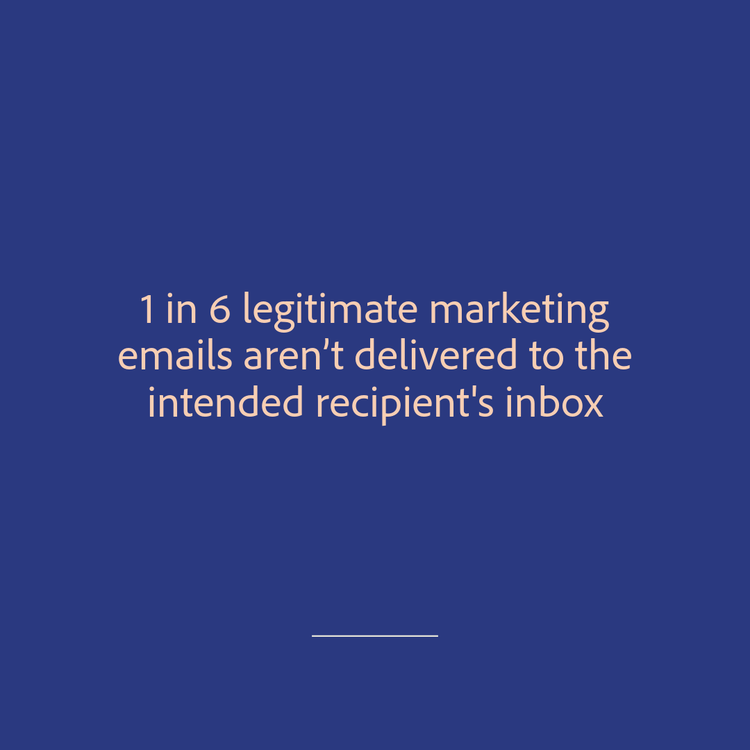Email deliverability best practices for peak and holiday seasons

Image credit: Adobe Stock/ Tierney.
The first whiff of pumpkin spice has arrived, and email marketers are already donning their Christmas sweaters and preparing for the most wonderful time of the year. During peak seasons or holidays, email volumes that can be over one hundred times higher than average, and marketers around the world want to capitalize and make the most of this time of year. Unfortunately, simply sending more emails won’t guarantee success — there’s so much more to it.
Email deliverability is the ability to deliver emails to a subscriber’s inbox, and is a critical factor for e-mail marketing success.
Email deliverability is a vital piece of the puzzle when creating a peak season email strategy. According to Validity’s Email Deliverability Benchmark report, 1 in 6 legitimate marketing emails aren’t delivered to inboxes, and 1 in 10 emails aren’t even accepted by Internet Service Providers (ISPs). With increased volumes, ISPs see a rise in negative metrics such as bounces, trap hits, and complaints, leading to increased scrutiny for all senders. With so many moving pieces leading up to holiday sending, it’s hard to know where to begin in creating a holiday deliverability strategy.

Read on for the do’s and don’t’s of email best practices so that you’re set up for the best possible deliverability success.
The do’s
- Check Email Infrastructure
The first item to check off your list before increased holiday sending is ensuring your sending infrastructure is best optimized for deliverability success. It is always a good idea before increasing volume to double check that SPF and DKIM are properly set up and passing. Making sure to check authentication early, a month or more before peak holiday sending, will ensure you have plenty of time to fix any errors before key promotions begin. This will let ISPs know your emails are coming from a legitimate and authorized email sender.
- Slowly Ramp Up to Intended Volumes
When it comes to a high sender reputation, consistency in volume is key. Spammers frequently exhibit erratic email sending behaviors with large peaks and valleys in sending volume. If you are anticipating a significant rise in sending volume this holiday, begin slowly ramping up your email volume now. Running a Reengagement Campaign during the Fall will allow subscribers to confirm their interest in your brand and allow you to slowly increase volume. A good rule of thumb is making sure that none of your email volumes exceed previous volumes by more than 25 percent. For optimal delivery, it is best to keep volumes around 1 million messages per day per IP address and avoid exceeding this amount. If you feel you will need additional IPs to accommodate your peak sending volume, these new IPs will need to be warmed as soon as possible.
- Send to Active Subscribers
There is always the temptation (and internal pressure) to send to as large of an email list as possible whether it be the holidays, product launch, event or anything newsworthy. When it comes to email, quality of your subscribers is always more important than quantity. Sending to inactive subscribers can lead to an increase of user complaints or spam trap hits which can damage your sender reputation and lead to spam placement. For the holidays, it is best practice to target subscribers who have opened or clicked in the last 12 months. It is always a good idea to run your active email list through a list cleansing service before the holidays to make sure you are working with the cleanest data possible.
- Optimize Send Times
Throughout the year, you likely have held to a consistent send time and schedule when sending email. Of course, it is always best to send according to your customers' expectations and preferences. However, due to increased volumes globally during the holiday season, rather than following standard send times at the top of the hour such as 10 AM or 3 PM, scheduling mail at 10:08 AM or 3:12 PM can lead to higher deliveries as there is less traffic at these times. Subscribers are unlikely to notice a slight shift in sending time.
- Monitor Sender Reputation
To make sure all your hard work is being delivered successfully to subscribers, it is always a good idea to monitor your sender reputation throughout the holiday season. Large ISPs such as Gmail and Microsoft offer postmaster sites through Gmail Postmaster Tools and Microsoft SNDS which will give you a snapshot or your reputation and complaints. Even though third-party tools are helpful, your own data will always be your best source of truth when determining deliverability success. A few metrics to focus on are:
- Delivered Rates: The higher the better! Anything below 90 percent delivered indicates a potential bounce issue that will need to be addressed.
- Bounce Rate: An overall bounce rate above 2 percent is always worth investigating to make sure you are not experiencing any reputation issues at specific ISPs.
- Complaint Rate: It is best practice to keep complaint rates below 0.2 percent. Monitor your “denylist” rate closely as this is direct feedback from your subscribers indicating they do not want to receive your mail.
- Engagement Rate (Open/Click): Monitor your open rates by domain. If a specific domain has a significantly lower open and click rate than other providers, then there could be a spam or rendering issue impacting performance.
Marketers do not want to miss out on the email channel’s estimated ROI of 38:1, especially during holiday sending as businesses double their marketing efforts to boost sales. With ISPs on high alert during the holidays due to drastic increases in volume worldwide, it is more important than ever to follow best practices to avoid messages landing in the spam folder or getting blocked altogether due to outdated sending practices. Anyone who has run into inbox placement issues before knows resolving these issues takes time, time you may not have during the busyness of the end of the year. Avoiding these three worst practices will set you up for increased deliverability success this holiday season.
Pitfalls to avoid
- Do Not Rent or Purchase Data
It is never recommended to send to rented or purchased lists. Aside from the fact that these addresses were not given the opportunity to properly opt-in, these lists are often full of spam traps and invalid domains. Sending to these lists will increase the risk of complaints and bounces, which can lead to a sharp decline in reputation during peak season.
- Avoid Sending to Inactive Audiences
It is not recommended to send to inactive audiences during peak season. Targeting this audience can lead to higher complaints and bounces which can damage your sender reputation. If you would like to send to inactive subscribers, consider running a reengagement campaign in the Fall before the holiday season.
- Avoid Large Spikes in Volume
Spikes and sudden dips in volume is seen as spammy behavior by ISPs and can result in deliverability issues. To be in best possible standing with ISPs, avoid sudden changes in send volume and focus on ramping volume slowly up and then back down.
Tis the season
Following these five recommendations and pivoting away from these three risky practices will lead to greater success with your email deliverability this holiday season. The sooner you begin planning your holiday email strategy the better!
To dig further into deliverability best practices, please reference our Email Deliverability Best Practice Guide.